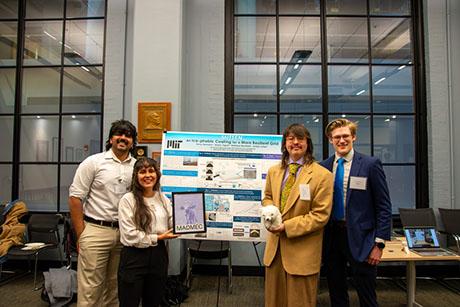Alumni Spotlight: LiquiGlide
Dave Smith (SM ’11)

Courtesy of LiquiGlide
Everyone has probably heard of LiquiGlide by now. Almost every media channel has reported on the company’s star product or published the now recognizable photo of ketchup easily sliding out of its downturned bottle, leaving a completely empty container behind. But how much have you heard about the company itself, for whom the innovative condiment bottle coating is just the beginning? MechE Connects had a chance to sit down with Dave Smith (SM ’11), LiquiGlide’s co-inventor and CEO, to discuss more than just the hype.
Where did the idea for LiquiGlide originate?
I’m motivated by different applications for reducing adhesion. My master’s research thesis with Professor Kripa Varanasi was on preventing clogs in oil and gas lines created by these big ice-like structures. So looking at different technologies for reducing adhesion made me very well aware of various adhesion problems. At the Varanasi Lab, we were always thinking about low-adhesion non-wetting surfaces. Seeing the success the technology could have in oil and gas lines, we thought it would be interesting to apply it to condiment bottles to prevent adhesion, using materials that are safe enough to eat.
How does it work?
Liquid-impregnated surfaces are comprised of two parts: the porous solid coating that is roughened or has patterned textures, and a liquid that fills up the voids between the features, or fills up the pores of the surface. It’s that liquid that gives it the slipperiness. So it is a lot like using oil in a frying pan, but in this case we made that oil layer permanent by trapping it in place by capillary forces. It is a platform technology, so you can use a lot of different materials. The fundamental science was published in a paper we wrote six months ago. In it, we talked about all of the different possible states you could end up in. That state depends upon your choice of solid and liquid materials and the properties of the material in shedding opposites. So for every material you want to shed off, you need to choose a solid and a liquid with different properties. That is a great thing, because you can get this effect from all kinds of different materials, you just need to put them together in different combinations. Much of the success depends on finding the best combinations of liquids and solids.
What makes it innovative and unique?
What’s really innovative is the fundamental science we discovered that allows you to make liquid-impregnated surfaces slippery. Certainly, trapping a liquid in a porous surface isn’t a new idea. In fact, we can see that by putting a piece of paper in water; it soaks up water and you have a liquid-impregnated surface – which is not necessarily going to be slippery. So it really took an in-depth dive into physical chemistry and fluid mechanics to recognize which chemical properties the solid and liquid need to have. We asked questions about the rheological properties the liquid had to have in order to create the slippery effect. No one had ever done that before, and that is why we have never seen this effect before.
Do you have pre-established criteria of what you’re looking for with different combinations?
Yes, that is right. We have an algorithm for selecting solid and liquid materials, and that algorithm is a function of the properties of the material that you want to shed off the surface.
What’s LiquiGlide’s business plan moving forward?
We have just started our first development project, and we are going to be developing several new projects this year with different companies – largely consumer-packaged goods companies (CPGs) – but there is no limit to LiquiGlide’s potential. It can be applied to many different industries, from unclogging processing lines to cooling power plants to de-icing planes. We’re also looking at other industries as well. As I mentioned, every product requires a certain set of materials. We always start off by developing a coating, which involves selecting materials that not only create a stable slippery impregnated surface but also satisfy the other requirements the particular application might have. Is it food safe? Is it FDA approved? Is it immiscible enough to give you a shelf life of two years? Every application has its own specific requirements we have to meet.

